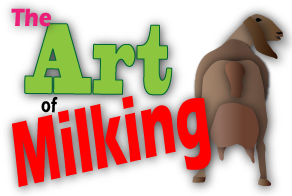
The Art of Goat Milking
Allergies
When Bryson was 3 years old, we discovered he was allergic to milk. Later we found out Shae also had a milk allergy. We did not want to use a milk substitute. After reading about the great benefits of goat’s milk, we decided to try it.
Finding a Farmer in the City
Off a main road, we found a small “milk” sign pointing down a long, winding driveway. There we found a local farmer tucked within the city limits that milked a single LaMancha goat. Mary was a sweet woman with a gentle demeanor. She 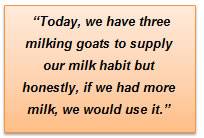 showed us her goat and we watched her milk.
showed us her goat and we watched her milk.
We began purchasing milk from her and continued for the next couple of years. Later, milking a goat would be a contributing factor in our decision to move to the country.
Moving to the Country
After moving, we were able to find two additional gals who sold us goats milk but it wasn’t until the third farmer, Nancy, that we discovered the secret to great tasting milk. It was simply cooling the milk immediately after milking. It was this milk in which both Gary and I, along with the two older kids, began to drink the milk and loved it.
Time to Milk a Goat
Today, we have three milking goats to supply our milk habit but honestly, if we had more milk, we would use it. After drinking it, making ice cream or chocolate milk, we do not have enough for cheese, butter or yogurt. It is a truly versatile food.
Goat Milk Myths
Here are some Goat Milk Myths we have discovered along our journey:
* Goat milk is not as good as cow milk.
* Need to feed goats a certain food to make the milk taste good (i.e. alfalfa hay or oats).
* Bucks cannot be raised near the milking does or it will "taint" the flavor of the milk. (We have found that because our goats roam on 5 acres, the smell is reduced and therefore, doesn't penetrate the milk.)
* If the goat eats a funny weed, it will come out in the milk. (This can be true but we counter it by making sure the goats have access to loose minerals to balance their systems.)
* You have to milk a goat twice a day or they will dry up. (We milk once a day.)
* Goats must be milked at the same time every day. (This is generally true but there is some flexibility in goats - each one is different.)
* Milking is done at the break of dawn. We milk our goats around 9am in the cooler months and 7am in the hot months - moving up and down in half hour increments as the weather changes.
So Many Ways
There are so many routines and ways to milk goats but this video shows how we milk ours:
Before we began milking, we needed a stanchion. We designed our first one from instructions in a farm magazine. Later, Garen found a way to use pallets and promptly made one for the neighbor. If you'd like to see the article/video on his Pallet Stanchion, click here.
We wait until the kids are about 2 to 3 weeks old before we start milking the does. The kids are separate the night before milking. We milk the does in the morning and put the kids back with theirmommas until evening when the process starts over.
We sometimes use fennel cream on the nursing goat udders just prior to milking. This causes the goats to “let down” their milk and helps to prevent mastitis. If you are further interested, you can click on Homemade Fennel Cream where Chef Shae shows how we make it.
Within minutes of milking the goats, the milk is filtered and put into the freezer. This is the "key" to great tasting milk. If we taste any "funny" flavors in the milk, they may be are out of loose minerals. Within a day of getting them back on minerals, the milk is up to our "drinking standard". That is, for everyone in the family but the two youngest - they don't mind any strange “goaty” flavors in the milk.
Forty-five minutes in the freezer cools the milk nicely. At this point, we can either pasteurized it (cook in double boiler at 145 degrees for 30 minutes) or place it in the refrigerator. If a person wants access to raw organic milk, this is one way to legally obtain it.
One thing we do to save a couple pennies is wash the milk filters with hot, soapy water and magnet them to the side of the metal oven hood to air dry. We can then reuse them a few times.
Milking Technique
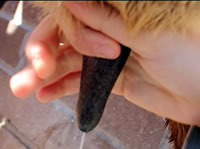
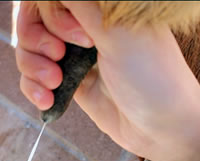
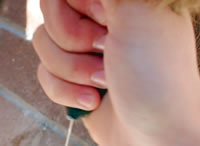
Sometimes we get on a “grass fed” kick and we use sweet hay like alfalfa to feed our goats during milking time. They are happy to eat it as well as the grain. We have fed both at different times. We may even throw in a banana or orange peels for a "treat" at milking time. One of the goats favorites is mesquite beans which sweeten the milk nicely.
Family Time
We enjoy going out as a family to care for the animals in the morning. Everyone has his or her jobs. The girls usually do the milking; the boys take care of bunnies and chickens. Goats get hay in the winter and forage when the land is producing enough "green". Then there is clean up which Gary heads up(endearingly called the "pooper scooper").
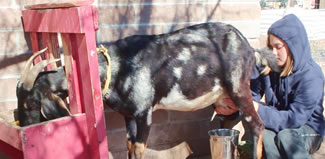
The process takes about 20 minutes. We keep a small number of animals so it does not become a burden for us. Gary and I want to give the kids a great growing up experience. The last thing we want is complaining about how hard it was living on a farm. This is also the reason we do not milk in the wintertime. We milk until it feels too cold for us - usually in November and then pick up again in March with the new batch of kids.
Storing Milk
During the summer, we store up extra milk in the freezer for the winter months. “Freezer” milk is not as good as fresh milk. The milk has to be completely thawed and shaken vigorously to redistribute the cream.
Milk Benefits
The article/video on the History of Milk is where we indirectly tell “why” we process our own milk. Milk is a hotly debated subject where both sides offer legitimate arguments as to whether we shouldcontinue to pasteurize milk today. The History of Milk is the reason we are strong proponents of drinking healthy milk. Milk can either be one of the most dangerous foods we can consume and yet, it can be the healthiest for our bodies - especially our young growing children. We believe milk is the reason that our kids do not have any cavities yet. Our youngest, Shae, who's 12, has been on goats milk for 10 years and has beautiful, strong teeth.
With all the foods today that are so "sanitized" that they cease to be food anymore, milk is a great answer. If we give children the best nutrition while their bodies are growing and developing, they will have a healthy foundation to fall back on when they are older. John Seymour, author of The Self-Sufficient Life, said in a Mother Earth News
article called, Start a 1-Acre, Self-Sufficient Homestead, “Nothing keeps the health of a family at a high level better than a dairy cow.”
Shelly
February 2013






